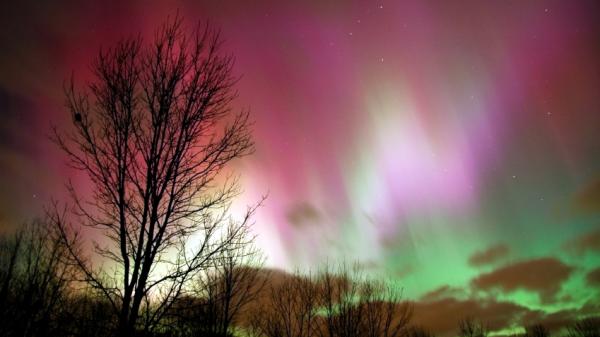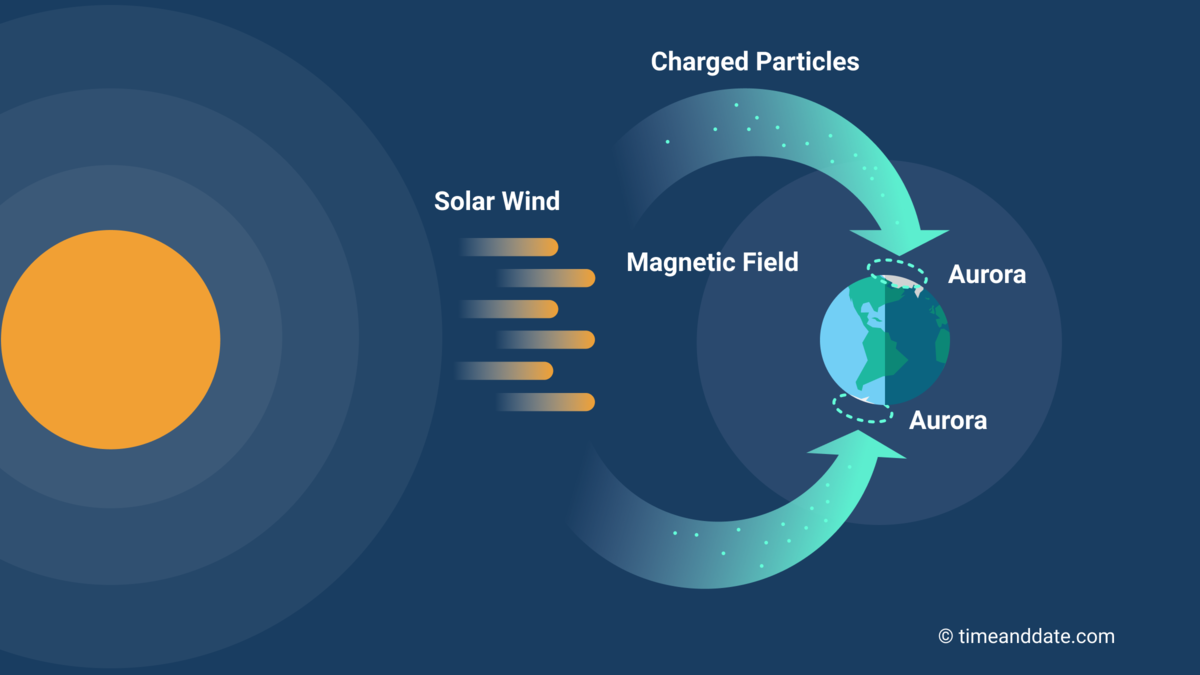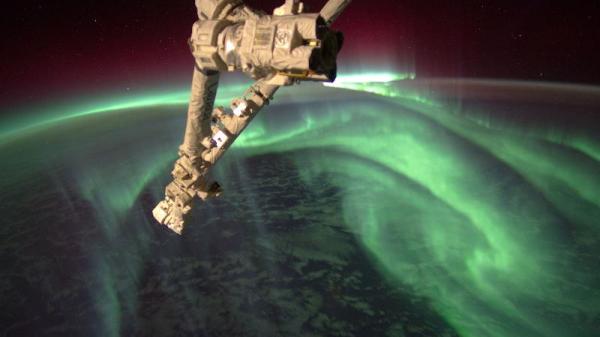What Are Northern and Southern Lights?
An aurora is a natural electric phenomenon that creates bright and colorful light displays in the sky. They are common at higher latitudes, mostly within the Arctic and the Antarctic Circles.

Aurora borealis in Michigan, USA. The northern lights can be green, pink, red, blue or violet in color.
©iStockphoto.com/Constance McGuire
In the Arctic Circle, they are known as aurora borealis or the northern lights, while in the Antarctic Circle they are called aurora australis or the southern lights.
These dramatic and colorful lights are created when electrically charged particles from solar winds enter the Earth’s atmosphere and interact with gases in the atmosphere.
Stream of High Energy Particles
The Sun continuously emits electromagnetic radiation and highly energized particles into space, which produce space weather. Solar wind is part of space weather. It is a continuous stream of highly energized particles – mostly electrons and protons – that flow out from the Sun through space at very high speeds and high temperature. Solar winds can reach speeds of one million miles per hour.
Earth: A Giant Magnet
The Earth is a giant magnet, with its magnetic field extending from the Earth’s core to the area in space where it meets solar winds. The region of this field where the Earth’s magnetic influence dominates over solar winds is known as the magnetosphere. Its shape and size continuously change as it gets bombarded by solar winds.


Northern lights are created by highly energized particles released from the Sun, known as solar wind.
©timeanddate.com
The Earth’s magnetosphere shields the Earth from solar winds and other harmful cosmic rays. It deflects most of the highly charged particles from solar winds and stops them from entering the Earth’s atmosphere.
High Energy Collisions
While the Earth’s magnetosphere is responsible for protecting it from the highly charged particles in the solar wind, sometimes, when the conditions are right, these particles enter the Earth’s atmosphere at the two poles, where they collide and interact with gas molecules and atoms.
When such collisions occur, the energy from the electrons in the solar winds is transferred to electrons in the atoms of different atmospheric gases. Any excess energy is then released by these excited atoms in the form of light.
Auroral light displays tend to occur at between 50 miles (80.46 kilometers) and 200 miles (321.87 kilometers) above the surface of the Earth.
Many Different Colors
The color of the light released depends on the kind of gas molecules, their electrical state at the time of collision, and the type of the solar wind particles they collide with. Oxygen atoms emit yellow-green or red colored light, while nitrogen atoms generate blue or purplish-red colored light. A mix of gases in the Earth’s atmosphere creates multicolored auroras.
Because particles from solar winds continually enter the Earth’s atmosphere and interact with gas atoms, aurora displays can be static as well as dynamic – they can change shape and colors, and pulsate in the skies.
And Many Different Shapes
Auroral shapes tend to fall in six categories – curtains, bands, veils, coronas, patches, and rays.

Southern lights seen from space. Picture taken by the Expedition 32 crew onboard the International Space Station from an altitude of about 240 miles (386 kms).
NASA
Best Places to See Northern Lights
If one were to look from space, they would see a ring-shaped aurora spanning around 2500 miles (4000 kms) around both poles. This auroral zone covers Central and northern Alaska and Canada, Greenland, northern Scandinavia, and Russia in the Northern Hemisphere, and Antarctica in the Southern Hemisphere. In the south, auroras can sometimes be seen from southern Australia, New Zealand, and Chile.
Sometimes a high level of solar activity can lead to strong and violent gusts of solar winds interacting with the Earth’s magnetosphere, causing a geomagnetic storm. This can expand the region around the poles where auroral activity can be observed from, increasing the chances of seeing auroras at lower latitudes.
On very rare occasions, auroral displays can be observed from locations close to the equator. For instance, in 1909, because of a very strong geomagnetic storm, people in Singapore were able to observe auroral displays.
When's the Best Time to See Auroral Lights?
While auroral activity and auroras can occur throughout the year, day and night, the best time to view them is at night during the winter months. This is because, during the winter, areas around the North and the South Poles have longer periods of darkness.
Auroras are best observed around midnight – when it is darkest – on a clear night, and at a location that is away from the city. Light sources – artificial or natural, like from a full Moon – can make it very hard to view the aurora.
11 Year Cycle
Auroras are directly connected to solar activity, which is measured by the number sunspots – dark spots on the surface of the sun caused by high magnetic activity on the Sun. A larger number of sunspots means that a larger number of highly charged particles are being pushed out by the Sun. This in turn can lead to more northern lights activity on Earth.
Solar astronomers have found that the Sun goes through cycles of solar activity. This cycle, also called the solar cycle, comes around every 11 years.
Scientists have observed 24 solar cycles since 1755 when solar activity started being recorded by humans. The 24th solar cycle is said to have reached its peak sometime in mid-2013.
Did You Know?
Auroras have been observed on some other planets as well. Any planet that has a magnetic field and an atmosphere will have auroral activity.